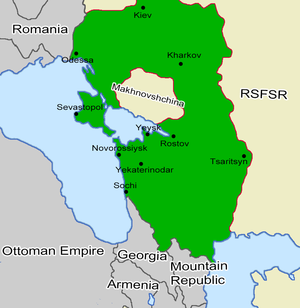
Back Узброеныя сілы Поўдня Расіі Byelorussian Streitkräfte Südrusslands German Ένοπλες Δυνάμεις Νότιας Ρωσίας Greek Etelä-Venäjän armeija Finnish Forces armées du Sud de la Russie French Ռուսաստանի հարավի զինված ուժեր Armenian Angkatan Bersenjata Rusia Selatan ID Forze armate della Russia meridionale Italian 南ロシア軍 Japanese 남러시아군 Korean
| Southern Russian Armed Forces | |
|---|---|
| Вооружённые силы Юга России | |
 Most territory controlled by South Russian forces as of October 1919 | |
| Active | 8 January 1919 – April 1920 |
| Country | South Russia |
| Allegiance | |
| Size | 85,000 (January 1919) 160,000 (July 1919) 270,000 (October 1919) |
| Engagements |
|
| Commanders | |
| Commander-in-Chief | Anton Denikin (until 4 April 1920) Pyotr Wrangel (from 4 April 1920) |
The Armed Forces of South Russia (AFSR or SRAF) (Russian: Вооружённые силы Юга России, romanized: Vooruzhyonniye sily Yuga Rossii, VSYuR) were the unified military forces of the White movement in southern Russia between 1919 and 1920.
On 8 January 1919, the Armed Forces of South Russia were formed, incorporating the Volunteer Army and the Don Army.[1] Subsequently, it included the Crimean-Azov Army, the Forces of Northern Caucasus and the Turkestan Army.
By October 1919, the army had 150,000 soldiers, which included 48,000 horsemen. The British had supplied 280,000 rifles, 4,898 machine guns, 917 cannons, 102 tanks, 194 airplanes 1,335 automobiles, 112 tractors, and what became known as Wrangel's fleet.[2]
In May 1919, Denikin reorganized the Armed Forces of South Russia. Vladimir May-Mayevsky took command of the Volunteer Army, known formerly as the Caucasian Volunteer Army. Sidorin took command of the Don army, while Wrangel took command of the Caucasian Army, consisting mainly of the Kuban Cossacks.[2]: 37–38
The Caucasus Army disbanded on 29 January 1920 and was replaced by the short-lived Kuban Army. Troops of the Kuban Army ended up surrendering by 18–20 April 1920 to the Red Army. The Volunteer Army continued to exist from 22 May 1919 until 26/27 March 1920, when the remaining troops were evacuated from Novorossiysk to Crimea. Most then merged there with Wrangel's forces.
In early April 1920, Anton Denikin, commander-in-chief of the AFSR, delegated all authority to Pyotr Wrangel, who took command of the so-called Russian Army, which included all remaining units of the AFSR after its defeat in Northern Caucasus.
- ^ Kenez, Peter (2004). Red Attack, White Resistance; Civil War in South Russia 1918. Washington, DC: New Academia Publishing. pp. 267–270. ISBN 9780974493442.
- ^ a b Kenez, Peter (2004). Red Advance, White Defeat: Civil War in South Russia 1919-1920. Washington, DC: New Academia Publishing. pp. 20–23. ISBN 9780974493459.
© MMXXIII Rich X Search. We shall prevail. All rights reserved. Rich X Search